Index:
- Main functions of plant nutrients
- Nutrient demand/uptake/removal
- Leaf analysis as a guidance tool for the nutrition of citrus
- Nutrient deficiency symptoms in Citrus
- Nitrogen (N)
- Phosphorus (P)
- Potassium (K)
- Calcium (Ca)
- Magnesium (Mg)
- Iron (Fe)
- Manganese (Mn)
- Zinc (Zn)
- Sulfur (S)
- Copper (Cu)
- Boron (B)
- Molybdenum (Mo)
- Salinity
- Salt injury
- Copper Toxicity
- Boron Toxicity
- Manganese Toxicity
- Biuret Toxicity
2.1 Main functions of plant nutrients
Table 4: Summary of main functions of plant nutrients
|
Nutrient |
Functions |
|
Nitrogen (N) |
Synthesis of proteins (growth and yield). |
|
Phosphorus (P) |
Cellular division and formation of energetic structures. |
|
Potassium (K) |
Transport of sugars, stomata control, cofactor of many enzymes, reduces susceptibility to plant diseases. |
|
Calcium (Ca) |
A major building block in cell walls, and reduces susceptibility to diseases. |
|
Sulfur (S) |
Synthesis of essential amino acids cystin and methionine. |
|
Magnesium (Mg) |
Central part of chlorophyll molecule. |
|
Iron (Fe) |
Chlorophyll synthesis. |
|
Manganese (Mn) |
Necessary in the photosynthesis process. |
|
Boron (B) |
Formation of cell wall. Germination and elongation of pollen tube. Participates in the metabolism and transport of sugars. |
|
Zinc (Zn) |
Auxins synthesis. |
|
Copper (Cu) |
Influences in the metabolism of nitrogen and carbohydrates. |
|
Molybdenum (Mo) |
Component of nitrate-reductase and nitrogenase enzymes. |
2.2 Nutrient demand/uptake/removal
Removal of mineral elements in the harvested fruit is one of the major considerations in formulating fertilizer recommendations. The table below shows the quantities of nutrient elements contained in one metric ton of fresh fruit. The large amounts of K reflect the high K content of citrus juice.
Table 5: Nutrients removed from the orchard by the fruit
|
|
Grams per Ton of fresh fruit |
||||
|
N |
P2O5 |
K2O |
MgO |
CaO |
|
|
Orange |
1773 |
506 |
3194 |
367 |
1009 |
|
Tangerine |
1532 |
376 |
2465 |
184 |
706 |
|
Lemon and Lime |
1638 |
366 |
2086 |
209 |
658 |
|
Grapefruit |
1058 |
298 |
2422 |
183 |
573 |
Table 6: Micronutrients removal from soil, by fruit, of different citrus varieties
|
Variety |
grams per ton of fresh fruit |
||||
|
Fe |
Mn |
Zn |
Cu |
B |
|
|
Orange |
3.0 |
0.8 |
1.4 |
0.6 |
2.8 |
|
Mandarin |
2.6 |
0.4 |
0.8 |
0.6 |
1.3 |
|
Lemon and lime |
2.1 |
0.4 |
0.7 |
0.3 |
0.5 |
|
Grapefruit |
3.0 |
0.4 |
0.7 |
0.5 |
1.6 |
2.2.1 Leaf analysis as a guidance tool for the nutrition of citrus
Using leaf analysis as one of the guides in planning citrus fertilizer programs has yielded a considerable cultivation progress. The table below relates to spring flush leaves, 4-6 months old, from non-fruiting terminals. Leaves from fruiting terminals (used in S. Africa and some S. American countries) have lower N, P and K, and higher Ca and Mg contents than leaves of the same age from non-fruiting terminals, a fact which should be borne in mind when interpreting leaf analysis data.
It is common to sample spring flush of healthy, undamaged leaves that are 4-6 months old on non-fruiting branches (Fig 2a). Selecting leaves that reflect the average size leaf from the spring flush. Typically, 75 to 100 leaves from a uniform 5-hectare block of citrus are sufficient for testing.
In some countries, it is recommended to sample spring grown leaves from bearing shoots, nearest to a fruit (Fig 2b).
Figure 2a: Sample leaves from the middle of non-fruiting shoots as shown above
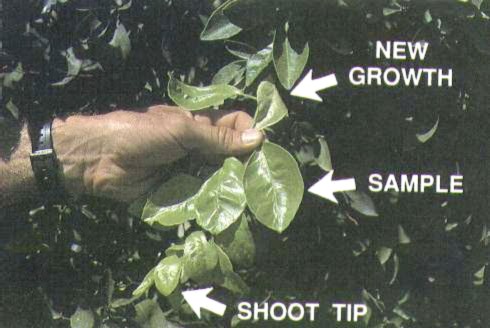
Figure 2b: Sampling spring grown leaves nearest to fruit
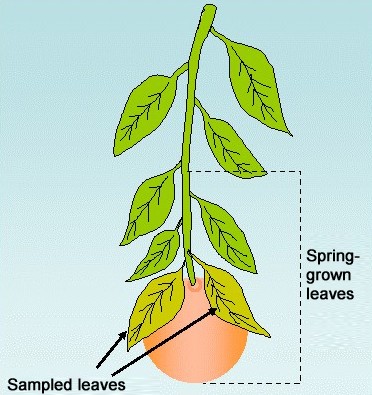
Table 7: Leaf analysis standards for Citrus (Florida)
|
Nutrient |
Type of Citrus |
Low (%) |
Good (%) |
High (%) |
|---|---|---|---|---|
|
N |
Naval |
2.00 |
2.20 - 2.60 |
> 2.80 |
|
Valencia |
1.90 |
2.10 - 2.40 |
> 2.70 |
|
|
Grapefruit |
1.60 |
1.80 - 2.40 |
> 2.60 |
|
|
P |
Naval |
0.09 |
0.11 - 0.16 |
> 0.19 |
|
Valencia |
0.09 |
0.11 - 0.16 |
> 0.19 |
|
|
Grapefruit |
0.10 |
0.13 - 0.17 |
> 0.20 |
|
|
K |
Naval |
0.60 |
0.70 - 1.70 |
> 1.80 |
|
Valencia |
0.70 |
0.90 - 1.80 |
> 1.80 |
|
|
Grapefruit |
0.50 |
0.70 - 1.70 |
> 1.80 |
2.3 Nutrient deficiency symptoms in Citrus
Nutrient deficiency symptoms appear on different plant parts, most frequently on leaves, fruits and roots. The mobility of nutrients is an important property from this point of view. Therefore, nutrients undergoing redistribution process e.g., when plant enters into reproductive- from vegetative phase.
Accordingly, various nutrients are classified as very immobile (B and Ca), very mobile (N, P, K, and Mg), immobile (Fe, Cu, Zn, and Mo), and slightly mobile (S). Symptoms are noticed on fruits for immobile nutrients like B and Ca. Development of visible symptoms is accountable to metabolic disorders, which cause changes in micro-morphology of plants before these symptoms are identifiable.
The way in which the symptoms develop and manifest on younger or older leaves, or the fruits, gives a reliable indication about the cause of nutritional disorders. Both deficiency and excess of nutrients can lead to reduction in crop yield, coupled with inferior fruit quality. Mild visible leaf symptoms, for some of the essential element deficiencies, can be tolerated without a reduction in yield in some citrus varieties, but not in others.
Various forms of deficiency symptoms are usually summarized as:
a. Stunted or reduced growth of entire plant with plant remaining either green or lacking in normal green luster or the younger leaves being light colored compared to older ones
b. Older leaves showing purple color, which is more intense on the lower side
c. Chlorosis of leaves either interveinal or the whole leaf itself, with symptoms either on the younger and/or older leaves or both
d. Necrosis on the margins, or interveinal areas of leaf, or the whole leaf on young or older leaves
e. Stunted growth of terminals in the form of rosetting, frenching, or smalling of leaves coupled with reduced terminal growth, or subsequent death of terminal portion of plants
2.3.1 Nitrogen (N)
Function: Nitrogen is one of the primary nutrients absorbed by citrus roots, preferably in form of nitrate (NO3 -) anion. It is a constituent of amino acids, amides, proteins, nucleic acids, nucleotides and coenzymes, hexosamines, etc. This nutrient is equally essential for good cell division, growth and respiration.
Deficiency Symptoms: Deficiency is expressed by light green to yellow foliage over the entire tree in the absence of any distinctive leaf patterns. With mild deficiency, foliage will be light green progressing to yellow as conditions intensify (Fig. 3a, 3b). New growth usually emerges pale green in color, but darkens as foliage expands and hardens. With yellow vein chlorosis, the midribs and lateral veins turn yellow, while the rest of the leaf remains with normal green color (Fig. 4). This chlorosis is frequently attributed to girdling of individual branches or the tree trunk. It may also occur with the onset of cooler weather in the fall and winter, due to reduced nitrogen uptake by the plant from the soil. Nitrogen deficiency is also associated with senescing foliage, which can develop a yellow-bronze appearance prior to leaf abscission (Fig. 5). Nitrogen deficiency will limit tree growth and fruit production, while high nitrogen applications produce excessive vegetative growth at the expense of fruit production, reducing fruit quality and threatening groundwater, particularly on vulnerable soil types.
Figure 3a: Nitrogen deficiency (Dark green leaf is normal; the other two leaves are deficient.)
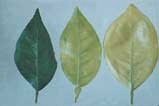
Figure 3b: Nitrogen deficiency (Aging, senescing leaves.)
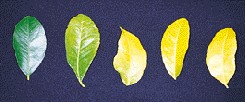
Figure 4: Pale new growth under N deficiency

Figure 5: Nitrogen deficient lemon foliage. Note that deficiency appears on the older leaves

2.3.2 Phosphorus (P)
Function: Phosphorus is one of the three primary nutrients, and is absorbed by citrus roots in the form of orthophosphate (H2PO4-) or HPO42-. It is a component of sugar phosphates, nucleic acids, nucleotides, coenzymes, phospholipids, phytic acid, etc. It plays a key role in the reactions involving ATP. The element is necessary for many life processes such as photosynthesis, synthesis and breakdown of carbohydrates, and the transfer of energy within the plant. It helps plants store and use energy from photosynthesis to form seeds, develop roots, speed-up the maturity, and resist stresses.
Deficiency symptoms:
Phosphorus has the tendency to move from older to younger tissues; therefore, symptoms appear first on older leaves, which lose their deep green color. Leaves turn small and narrow with purplish or bronze lusterless discoloration. Some leaves may later develop necrotic areas, and young leaves show reduced growth rate. Fruits are rather coarse with thick rinds (Fig. 6) and have lower juice content, which is higher in acid. Although rarely observed, foliage may exhibit a bronze appearance. Phosphorus deficiency is unlikely to occur in orchards that have received regular P applications in the past.
Figure 6: Phosphorus deficiency symptoms on fruits

2.3.3 Potassium (K)
Function: Potassium (K) is required as a cofactor for 40 or more enzymes. It is required for many other physiological functions, such as formation of sugars and starch, synthesis of proteins, normal cell division and growth, neutralization of organic acids, regulating carbon dioxide supply by controlling stomatal opening and improving efficiency of sugar use, overcoming environmental stress such as frost by decreasing the osmotic potential of cell sap.
Due to higher ratio of unsaturated/saturated fatty acid, a role in imparting drought tolerance, regulation of internal water balance and turgidity, regulating Na influx and/or efflux at the plasmalema of root cells, chloride exclusion behavior through selectivity of fibrous roots for K over Na, and imparting salt tolerance to cells to enable holding the K in the vacuole against leakage, when Na incurs in external medium.
Table 8: Positive effect of K on yield, fruit size and quality in sweet oranges
|
K2O |
Fruit weight |
Yield |
Juice |
TSS |
Acidity |
|
g/tree |
g |
Kg/tree |
% |
% |
% |
|
0 |
165.2 |
31.9 |
46.3 |
9.77 |
0.549 |
|
200 |
173.1 |
36.2 |
47.2 |
9.89 |
0.542 |
|
400 |
178 |
37.5 |
47.2 |
10.06 |
0.533 |
Deficiency Symptoms: Early K-deficiency symptoms are commonly in the form of stunted growth, sparse somewhat bronzed foliage, and a lusterless appearance of leaves. Under acute K-deficiency, the leaves wrinkle and twist, and only weak new lateral shoots emerge, because of lack of mechanical strength. Other symptoms are: reduced fruit size (Fig. 7a, 7b) with very thin peels of smooth texture, premature shedding of fruits (Fig. 11), leaf scorching, appearance of resinous yellow spots, and shoots turning S-shaped.
Figure 7a: K affects the size of orange fruit
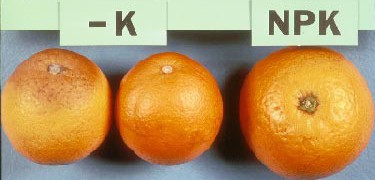
Figure 7b: Potassium deficiency symptoms on fruits (Left one is normal and smallest fruit is the most K-deficient).

Figure 8: K affecting the rind - have smoother, thinner rinds, susceptible to diseases
Plugging - removal of the peel in the stem-end area of the fruit; increases incidence of postharvest decay

Figure 9: Creasing - rind disorders, albedo breakdown, causing narrow sunken furrows on the rind surface as the peel disintegrates easily.

Figure 10: Splitting – vertical split at the styler or blossom-end and opening longitudinally towards the stem end.


Fading of chlorophyll, appearing as blotches, takes place in distal half of leaf. These blotches appear pale yellow at first, but later deepen to bronze, as they spread and coalesce, with leaf tips turning brown, showing abnormally variegated chlorosis in the form of amarelinho. Appearance of yellow to yellow-bronze chlorotic patterns on older leaves, along with corky veins, is also seen (Figs. 12a-c).
A screw-type of curling towards the lower leaf surface, particularly on lemon is more common. Many a times, fruits attain more growth in the longitudinal direction leaving restricted fruit growth equatorially; eventually fruits turn elliptical in shape.
Figures 12a-c: Chlorosis of older leaves. K-deficient leaves turn golden yellow, and bend downward at the tip and margins.
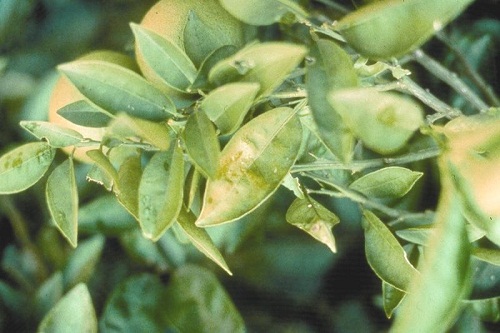
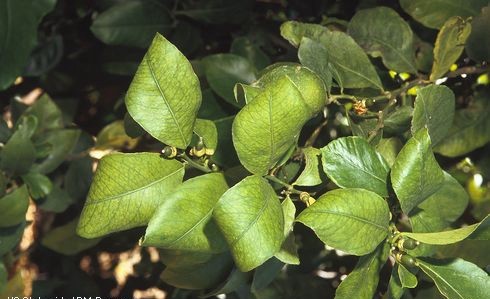
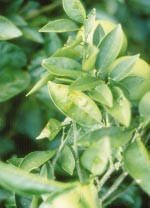
Potassium deficiency is likely to occur on calcareous soils due to elemental antagonism, and where large crops of fruit are produced with high nitrogen rates. A rarely observed bronzing of foliage may sometimes be observed, particularly on lemons. Potassium deficiency is associated with accumulation of cadaverine, acid invertase, lysine, histidine, arginine carboxylase, and reduced activity of carbamyl putrescine amine hydrolase, and pyruvate kinase. These are considered useful biochemical markers for establishing K-deficiency in citrus.
Table 9: Response of citrus yield and quality parameters to K fertilization as indicated by leaf K *
Thicker arrow = more pronounced effect
2.3.4 Calcium (Ca)
Function: Calcium is one of the secondary nutrients, absorbed by plant roots as Ca2+. Calcium is a constituent of the middle lamella of cell walls as Ca-pectate. It is required as a cofactor by some enzymes involved in the hydrolysis of ATP and phospholipids. It is an important element for root development and functioning; a constituent of cell walls; and is required for chromosome flexibility and cell division. Calcium deficiency appears to be a special case in which leaf chlorosis indeed reflects a broader interference involving alterations in nitrogen metabolism.
The reduced activity of pyruvate kinase is considered an indicator of Ca-deficiency.
Deficiency Symptoms:Deficiency of Ca is mainly characterized by fading of chlorophyll along the leaf margins and between the main veins, especially during winter months. Small necrotic (dead) spots develop in the faded areas. Small thickened leaves cause loss of vigor and thinning of foliage under severe conditions. Twig die-back and multiple bud growth develop from new leaves with undersized and misshapen fruits having shriveled juice vesicles, commonly referred as bronzing or copper leaf.
Chlorosis along leaf margins, leaves misshapen, often abscise rapidly.
Roots underdeveloped, may decay .Tree shows dieback and stunted Breakdown' Fruits show creasing and cracks form underneath the rind, with splitting and separation of the rind (Fig. 13).
Figure 13: Creasing resulted by calcium (Ca) deficiency

2.3.5 Magnesium (Mg)
Function: Magnesium is another secondary macronutrient absorbed as Mg+2. Magnesium is a central constituent of the chlorophyll molecule. A large number of enzymes involved in phosphate transfer require it nonspecifically. It is involved in photosynthesis, carbohydrate metabolism, synthesis of nucleic acids, related to movement of carbohydrates from leaves to upper parts, and stimulates P uptake and transport, in addition to being an activator of several enzymes.
Deficiency Symptoms: The deficiency of Mg is commonly referred to as bronzing or copper leaf symptoms. Symptoms of Mg-deficiency occur on mature leaves following the removal of Mg to satisfy fruit requirement. Disconnected yellow areas or irregular yellow blotches start near the base along the mid-rib of mature leaves that are close to fruits. These blotches gradually enlarge and coalesce later to form a large area of yellow tissue on each side of the mid-rib. This yellow area gradually gains in size, until only the tip and the base of the leaves are green, showing an inverted V-shaped area pointed on the mid-rib. With acute deficiency, leaves may become entirely yellow-bronze and eventually drop (Fig. 15 a-c). Seedy fruits are more severely affected than cultivars producing seedless fruits. Within the tree itself, heavily fruited limbs develop extreme Mg-deficiency symptoms, and may even become completely defoliated, while limbs with little or no fruits may not show deficiency symptoms. An increase in concentration of alkaline invertase is considered biochemical markers of K-deficiency in citrus.
With acute deficiency, leaves may become entirely yellow-bronze and eventually drop (Fig. 13). Magnesium deficiency occurring in calcareous soil may have to be corrected with foliar applications. Spaying Magnisal™, magnesium nitrate, is an effective treatment to correct Mg2+ deficiency.
Figure 14: Severe (left) and moderate (right) Mg deficiency
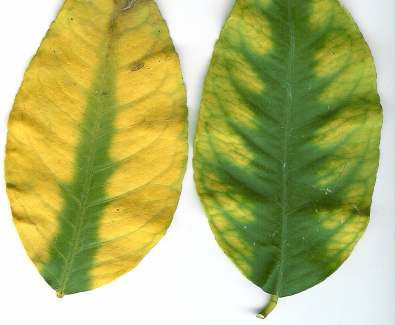
Figure 15 a-c: Magnesium (Mg) deficiency symptoms on citrus leaves
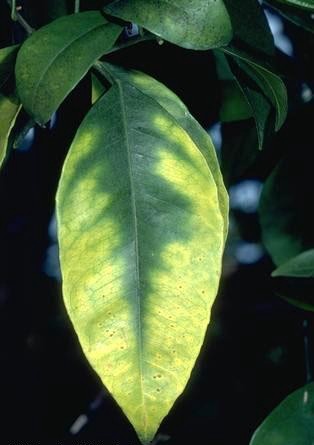
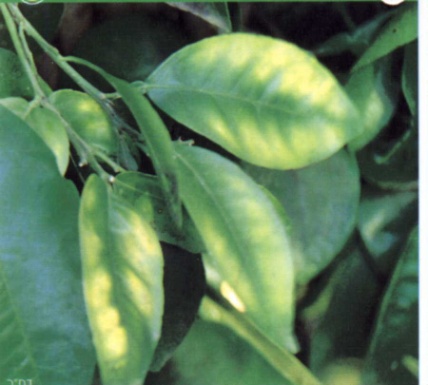
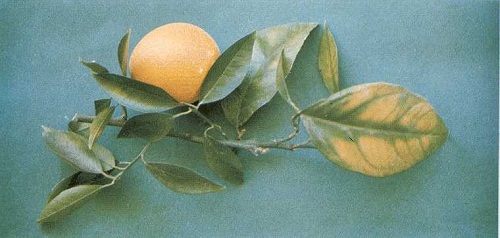
2.3.6 Iron (Fe)
Function: Iron, a micronutrient, is a constituent of cytochromes, non-haeme iron proteins, involved in photosynthesis, and N2 fixation and respiratory linked dehydrogenises. Iron is also involved in the reduction in nitrates and sulfates, the reduction in peroxidase and adolase. The increase in carbonic anhydrase activity is considered effective marker of Fe -deficiency.
Deficiency Symptoms: Lime induced Fe-deficiency is the most common form of deficiency. Interveinal white chlorosis due to Fe-deficiency appears first on young leaves. In mild cases, leaf veins are slightly darker green than interveinal areas with symptoms appearing first on new foliage (Fig. 16). In severe cases, interveinal areas become increasingly yellow with entire area eventually becoming ivory in color with emerging foliage, which is smaller. In some cases, leaves remain completely bleached, andmargins and tips are scorched. In acute cases, the leaves are reduced in size, turn fragile and very thin, then shed early (Fig 17).
Trees dieback severely from the periphery, especially at the top, and some trees have dead tops with the lower limbs showing almost normal foliage. Trees may become partially defoliated with eventual twig and canopy dieback.
Iron deficiency is usually an indication of calcareous soil condition and is more likely to be expressed on high pH-sensitive rootstocks like Swingle citrumelo. An early expression of flooding damage to roots and of copper toxicity may be iron deficiency symptoms.
Figure 16: Iron (Fe ) deficiency symptoms on young citrus leaves

Figure 17: Develoment of iron (Fe) deficiency in lemon. Left- healthy leaf; right- severe deficiency

Figure 18: Iron (Fe) deficiency symptoms on lemon foliage. Note that leaves are young, but are generally full size.
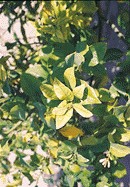
2.3.7 Manganese (Mn)
Function: Manganese is one of the redox micronutrients, absorbed by the plant roots in the form of Mn+2. It is required for the activity of some dehydrogenases, decarboxylases, kinases, oxidases, peroxidases, and non-specifically by other divalent, cation-activated enzymes, and is required for photosynthetic evolution of O2, besides involvement in production of amino acid and proteins. Manganese has equally strong role in photosynthesis, chlorophyll formation and nitrate reduction, and is indispensable for the synthesis of ascorbic acid, emerging from secondary effects of the fertilizer. A metalloenzyme peroxidase concentration is considered the marker of Mn deficiency. Accumulation of xylose and increased activity of peroxidase are considered useful biochemical markers of Mn deficiency in citrus in addition to reduced activity of phenylanine lyase, tyrosine ammonia lyase, and polyphenol oxidase.
Deficiency Symptoms: Deficiency appears as dark green bands along the midrib and main veins surrounded by light green interveinal areas (Fig. 19) giving a mottled appearance (Fig. 20). In more severe cases, the color of leaves becomes dull green or yellowish green along the mid-rib, and main lateral veins turn pale and dull for the interveinal areas. Chlorosis appears first on younger leaves, then spread gradually to older leaves (Fig. 21. Stems remain yellowish green, often hard and woody. Young leaves commonly show a fine network of green veins on a lighter green background, but the pattern is not distinct as in Zn and Fe deficiencies, because the leaves remain green.
Both manganese and zinc deficiencies may occur on calcareous soil and may be more severe on trees with highly pH-sensitive rootstocks. Incipient manganese symptoms may sometimes disappear as the season progresses, so leaves should be observed several times before remedial action is taken. Soil and foliar applications may be effective in correction of manganese deficiency.
Figure 19: Manganese (Mn) deficiency
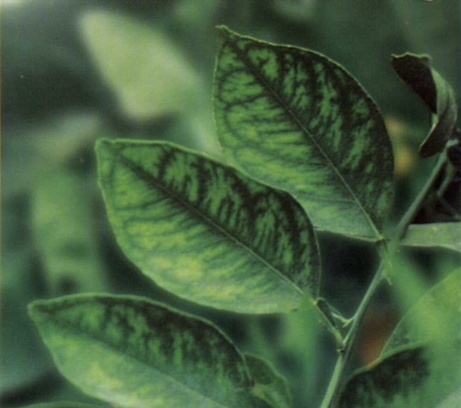
Figure 20: Mn deficient leaves show mottled appearance
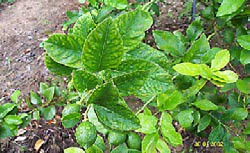
Figure 21: Manganese deficiency symptoms in lemon, showing normal leaf (left) and typical interveinal chlorosis (right)
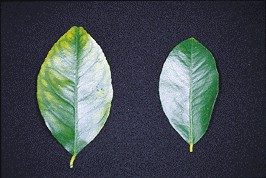
2.3.8 Zinc (Zn)
Function: Zinc deficiency is a common problem world over. It is an essential constituent of many enzymes such as alcohol dehydrogenase, glutamic dehydrogenase, lactic dehydrogenase, carbonic anhydrase, regulating equilibrium between carbon dioxide; alkaline phosphatase, carboxypeptidase, and other enzymes such as dehydropeptidase and glycylglycine dipeptidase for protein metabolism. It also regulates water relations, improves cell membrane integrity, and stabilizes sulflahydryl groups in membrane proteins involved in ion transport.
Deficiency Symptoms: Little leaf, rossetting, mottle leaf, frenching etc. The young leaves from vegetative shoots are more affected than reproductive shoots. The symptoms of Zn-deficiency are also characterized by irregular green bands along the mid-rib and main vein on a background of light yellow to almost white (Fig 22). Relative amounts of green and yellow tissue vary from a condition of mild Zn-deficiency showing in small yellow splotches between the larger lateral veins, to a condition in which only a basal portion of the mid-rib is green and the remainder of the leaves remain yellow to white. In severe Zn-deficiency, the leaves turn abnormally narrow and pointed with the tendency to stand upright coupled with extremely reduced size (Fig 23). As the deficiency progresses, the leaves are affected over the entire periphery of the tree, and the twigs become very thin and later dieback rapidly. A profuse development of water sprouts takes place. Some of the metallo-enzyme viz., carbonic anhydrase, nitrate reductase, and indole-acetic acid are suggested as biochemical markers of Zn-deficiency.
Figure 22: Zinc (Zn) deficiency
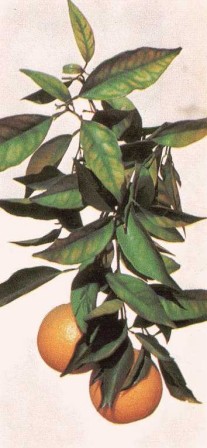
Figure 23: Leaves showing symptoms of severe Zn deficiency
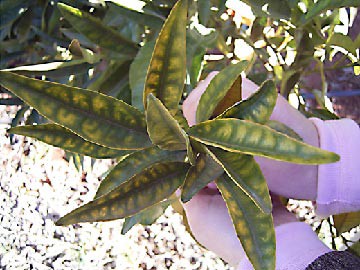
2.3.9 Sulfur (S)
Function: Sulfur is essential for protein formation, as a constituent of the three amino-acids cystine, cysteine and methionine. Sulfur is required for the formation of chlorophyll and for the activity of ATP - sulfurylase. These essential functions permit the production of healthy and productive plants, which are capable of giving high yields as well as superior quality.
Deficiency Symptoms:When plants do not get enough S, they may show visual symptoms of S deficiency. The classical symptom is a yellowing of younger leaves while old leaves remain green. Plants deficient in S often mature late. Symptoms of S deficiency occur particularly in plants well supplied with nitrogen but are some times confused with that of nitrogen. In this instance, leaf analysis can be invaluable.
Symptoms: Yellowing of new growth smaller leaves and abscise prematurely. Dieback of new shoots. Fruit undersized and misshapen (Fig. 24).
Figure 24: Sulfur (S) deficiency
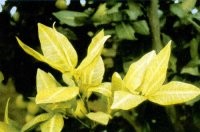
2.3.10 Copper (Cu)
Function: Copper plays an active role in enzymes performing key functions like respiration and photosynthesis and Cu-proteins have been implicated in lignification, anaerobic metabolism, cellular defense mechanism, and hormonal metabolism. Known forms of Cu in the plants comprise cytochrome oxidase, diamine oxidase, ascorbate oxidate, phenolase, leccase, plastocyanin, protein having ribulose biphosphate carboxylase activity, ribulose biophosphate oxygenase activity, superoxide dismutase, plantacyanin, and quinol oxidase. Copper proteins exhibit electron transfer and oxidase activity. Ascorbic acid oxidase is widely distributed and responsible for catalysing oxidation of ascorbic acid by oxygen. Copper is also a constituent of cytochrome oxidase and haeme in equal proportions. It also acts as a terminal electron acceptor of the mitochondrial oxidative pathway.
Deficiency Symptoms: copper deficiency is commonly known as exanthema. Wilting of terminal shoots, frequently followed by death of leaves is usually seen in Cu-deficiency.
Mild copper deficiency is usually associated with large, dark green leaves on long soft angular shoots. Young shoots may develop into branches, which appear curved, or “S-shaped," referred to as “ammoniation” usually resulting from excessive nitrogen fertilization (Fig. 25). Twigs can develop blister-like pockets of clear gum at nodes (Fig. 26). As twigs mature, reddish brown eruptions may occur in the outer portion of the wood. Severely affected twigs commonly die back from the tip with new growth appearing as multiple buds or “witches broom”. Necrotic-corky areas on the fruit surface may sometimes occur in extreme situations (Fig. 27) . Copper deficiency is more likely to occur in new plantings on previously uncropped soils, which are usually deficient or totally lacking in copper.
Figure 25: Copper (Cu) deficiency in citrus twigs
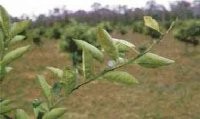
Figure 26: Cu deficiency showing gum pocket at node
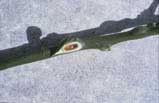
Figure 27: Copper (Cu) deficiency - necrotic-corky areas on the fruit surface
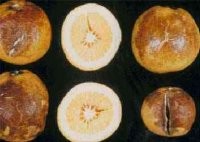
2.3.11 Boron (B)
Fruit symptoms most indicative of boron deficiency include darkish-colored spots in the white albedo of fruit and sometimes in the central core (Fig.28). Fruit may be somewhat misshaped with a lumpy surface. Young leaves are dull brown/green, water soaked areas may develop. Leaves are thick, curled with pronounced veins on upper surface. Bark of twigs may split, fruits are small (Figs. 29 a and b).
Unlike other micronutrient deficiencies, boron can affect fruit quality and therefore should be avoided. On the other hand, even slight excess of boron can cause toxicity (see page 29), so maintenance or correctional applications should be done very carefully, involving either soil or foliar applications, but not both.
Figure 28: Boron deficiency symptoms in red grapefruit
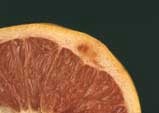
Figure 29 a-b: Boron deficiency symptoms on leaves
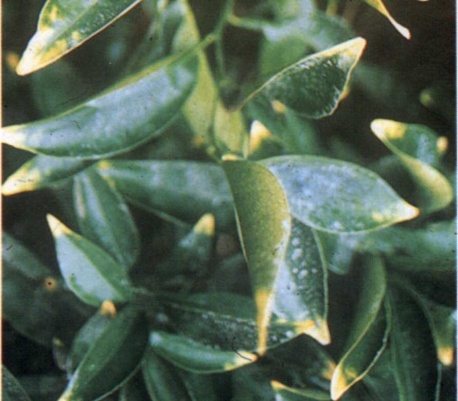
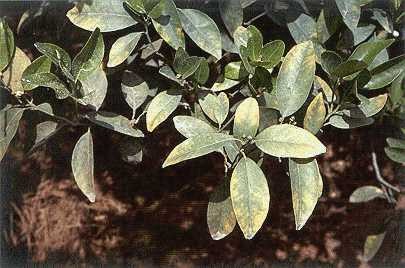
2.3.12 Molybdenum (Mo)
Deficiency of molybdenum in citrus is rare. It can occur under acidic soil conditions. The most characteristic field symptoms are large yellow spots on the leaves that appear first as less defined water-soaked areas in spring (Fig.30), later developing into distinct larger interveinal yellow spots.
Figure 30: Molybdenum deficiency symptoms
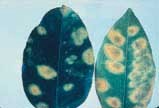
2.4 Special citrus sensitivities
2.4.1 Salinity
Citrus is sensitive to high concentrations of salt (sodium chloride) in the soil or in irrigation water. Salt toxicity causes leaf burn and yellowing, starting near the tip. Leaf drop is heavy and dieback follows. Older leaves show the symptoms first.
Citrus is moderately sensitive to salinity: Sensitivity Threshold = 1.7 dS/m;
Yield decline slope (beyond threshold) = 16 % / EC unit (Fig. 31 - 35).
Figure 31: The effect of chloride on citrus fruit yield
Figure 32: salinity-resulted tip burn
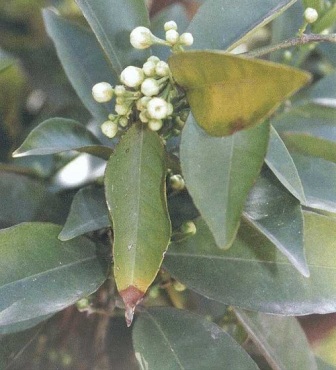
Figure 33: Salinity - Twig dry out
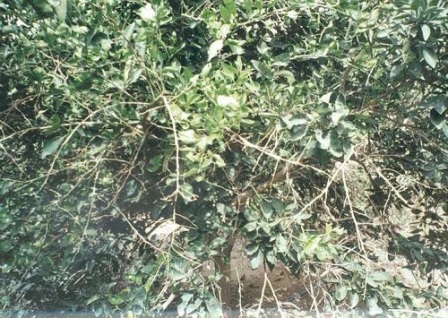
Figure 34: Twig dry out
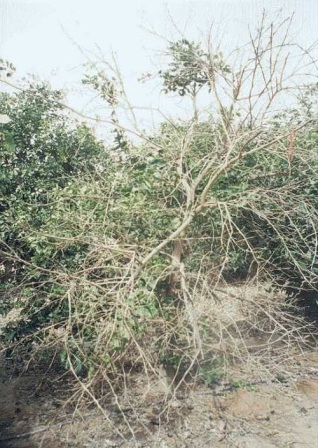
Figure 35: Wide areas of chlorosis along the margins and between veins of lemon leaves due to high salt concentrations
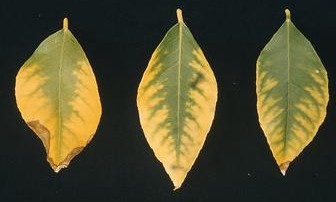
Symptoms of salt toxicity often begin as yellowing and grey or light-brown burn of the leaf tip. The burn extends back from the tip and then develops along the edges of other parts of the leaf edge. A variable degree of yellowing can develop ahead of the burnt tissue.
The tolerance limit of salinity in the root-zone for ‘Valencia’ oranges is estimated at an EC of 2.5 - 3.0 ds/m. The growth of citrus species and their fruit yield is generally reduced at soil electrical conductivities (EC) above 1.4 ds/m. Salinity, not only reduces growth and yield due to the osmotic potential effect, but for the same reasoning salinity delays and depresses emergence, reduces shoot and root biomasses.
The use of more tolerant scions and salt-excluding rootstocks helps minimize salt injury to trees and loss of production. Lemons are more susceptible than grapefruits or oranges. Citrus on rough lemon rootstock are more susceptible to salt toxicity than those on Troyer or Carrizo citrange, with sweet orange stock being the most tolerant of the stocks commonly used for oranges. Poncirus trifoliata rootstock allows high levels of chloride to accumulate in the tree, whereas Rangpur lime and Cleopatra mandarin stocks are the most effective in excluding chloride, where their use is appropriate.
Multi-K (potassium nitrate - KNO3) combats successfully salinity by suppressing the uptake of chloride and sodium. The antagonistic effects of nitrate-nitrogen (NO3-) and potassium (K+) suppress these ions, Cl- and Na+. The higher concentration of Multi-K in the soil solution, the better results of combating salinity can be expected (Fig. 36-37).
Figure 36: The Effect of Multi-K potassium nitrate on chloride content of a citrus leaf under saline conditions. Multi-K treatment: constant concentration of 200ppm in the irrigation water.
Figure 37: Multi-K potassium nitrate increases nitrate content in citrus leaves under saline conditions. Multi-K treatment: constant concentration of 200ppm in the irrigation water.
High sodium level in the soil damages its particles structure and reduces water penetration. High sodium competes with potassium uptake, leading to potassium deficiency and upset tree nutrition. Correcting the salinity often restores normal potassium nutrition. When applying potassium fertilizer in saline areas, Multi-K (potassium nitrate - KNO3) should be used and not potassium chloride (muriate of potash). This is an effective way to minimize the salinity problem since the cation K+in Multi-K, due to the antagonistic effect, will successfully suppress the uptake of sodium (Na+) and increase the K+ in leaves (Fig. 38-39) and in results, Multi-K increases yield (Fig. 40).
Figure 38: Multi-K potassium nitrate reduces Sodium (Na) content in citrus leaves under saline conditions. Multi-K treatment: constant concentration of 200ppm in the irrigation water.
Figure 39: Multi-K potassium nitrate increases K content in citrus leaves under saline conditions. Multi-K treatment: constant concentration of 200ppm in the irrigation water.
Figure 40: The Effect of Multi-K potassium nitrate on the yield of citrus under saline conditions
2.4.2 Salt injury
Many salinity-induced symptoms are similar to drought stress symptoms, including reduced root growth, decreased flowering, smaller leaf size, and impaired shoot growth. These can occur prior to more easily observed ion toxicity symptoms on foliage. Chloride toxicity, consisting of burned necrotic or dry appearing edges of leaves, is one of the most common visible salt injury symptoms. Actual sodium toxicity symptoms can seldom be identified, but may be associated with the overall leaf “bronzing” (Fig. 41) and leaf drop characteristic of salt injury. Slightly different symptomology may occur depending on whether injury is due to root uptake or foliage contact. Excessive fertilizer applications, highly saline irrigation water, and storm-driven ocean sprays can all result in salinity-induced phytotoxic symptoms.
Figure 41 a-b: Salt injury
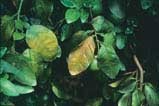
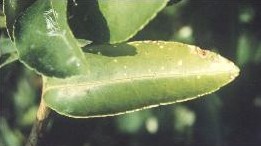
2.4.3 Copper Toxicity
Symptoms can include thinning tree canopies, retarded growth and foliage with iron deficiency symptoms. Feeder roots may also become darkened, and show restricted growth. When extractable copper exceeds 100 pounds per acre, (1.12 kg/ha) trees may begin to decline. Old citrus land should be checked for soil copper before replanting. High soil copper levels may be ameliorated by liming to pH 6.5. The rootstock Swingle citrumelo is known to be quite susceptible to high soil copper.
2.4.4 Boron Toxicity
Early stages of boron toxicity usually appear as a leaf tip yellowing or mottling (Fig. 42). In severe cases, gum spots appear on lower leaf surfaces (Fig. 43) with leaf drop occurring prematurely. Severe symptoms can include twig dieback.
Figure 42: leaves showing the signs of boron toxicity
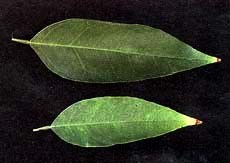
Figure 43: Gumming on underside of leaf
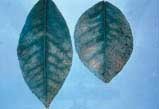
Figure 44: Necrosis at the tips and chlorosis beginning between the veins of Valencia orange leaves due to excessive boron
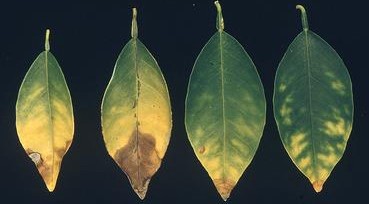
High boron level in the irrigation water or in the soil may be problematic for growing citrus. Only in cases where the soil is the source of high boron, leaching irrigations and improved drainage will control the problem.
Rootstocks and scions differ in their susceptibility to boron toxicity. Citrus on rough lemon stock are more affected than those on sweet orange or Poncirus trifoliata rootstock. Lemons are the most susceptible scion, followed by mandarins, grapefruit and oranges.
2.4.5 Manganese Toxicity
Manganese toxicity symptoms are occasionally found in citrus growing in very acid soils (usually below pH 5.0). The soil may be naturally acidic or have become acidic through continued heavy applications of strongly acidifying fertilizers, particularly ammonium sulfate.
Yellowing around the outer part of the leaves, especially of the older leaves, is the most characteristic effect of manganese toxicity in lemons. The yellowing is very bright and is described as 'yellow-top' (Fig. 45). Affected oranges and mandarins develop dark brown spots 3-5 mm in diameter, scattered over the leaves (tar spotting) (Fig. 46).
Figure 45: Manganese toxicity in lemons
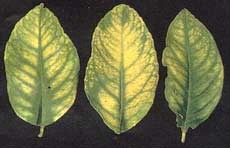
Figure 46: Manganese toxicity signs on orange leaf
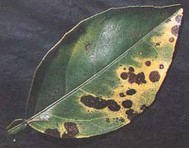
Toxicity is more common in loamy soil than in sands. Damp, poorly drained soil encourages the build-up of soluble manganese. Lemons, oranges, mandarins and grapefruits are all affected. Trees on P. trifoliata rootstock are affected worst, but the problem is also found in trees on rough lemon stock.
Applications of multi-K potassium nitrate, whenever K fertilization is required, help to increase the soil pH and may help to prevent the manganese toxicity phenomena.
2.4.6 Biuret Toxicity
Biuret is an impurity in urea fertilizer, which may be avoided using only guaranteed low-biuret urea products, particularly for foliar sprays. Leaf symptoms appear as irregular, yellowish-green interveinal chlorotic areas appearing first at leaf tips and spreading over the entire area of the leaf surface (Fig. 47). As severity increases, only the midribs and parts of the major veins remain green.
Figure 47: Lemon leaves with signs of biuret toxicity
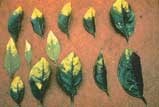
Need more information about growing citrus? You can always return to the citrus tree fertilizer & citrus crop guide table of contents
For more information visit our iron deficiency in plants and soils!
Related Articles:
NPK Fertilizers - Water Soluble Fertilizers
Informations about Plant Nutrient deficiency
Informations about Calcium Nitrate Fertilizer
Map Fertilizer - More Informations



